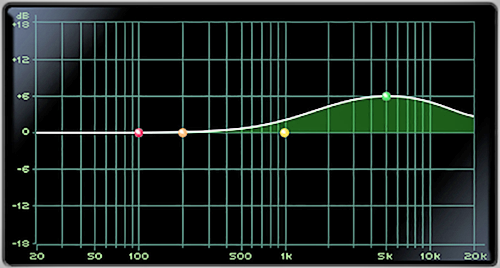 By Dave Foxx
By Dave Foxx
Happy New Year! I sincerely hope that 2014 brings you loads of personal and professional success. Since we have to start dating our checks differently, we all seem to choose this time of year as a time to “start fresh,” to make a new beginning. To that purpose, I want to re-dedicate this space to helping you achieve your goals as a creative radio producer, whether you’re doing imaging or commercial work. It is my plan this year to offer more practical tips and ideas. I have tended to get into philosophical discussions with myself a lot lately, and while I think these discussions are helpful, I’d really like to start connecting the dots a little more by bridging the philosophy to more concrete “things you can do.” So, let’s kick the New Year off with a broad list: Five Simple Things You Can Do to Improve Your Production.
Brighten The VO
I don’t know about you, but when I hear a commercial or promo as a listener, I am irritated beyond belief when I have a hard time understanding what the VO is saying. A lot of VO talents in this world spend an inordinate amount of time trying to sound like the late Don LaFontaine. His voice was iconic to moviegoers. His testosterone-laden sound was truly magnificent, thundering out of the cinema with “In a world where man has forgotten to turn off the iron,” it’s NOT a sound very many people can do. I want to tell VO artists; his voice was deep. Your voice is deep. That’s good, but the truth is, the pitch isn’t the key factor. It’s the glottal fry. It’s the enunciation. It’s the resonance. Now, the resonance is not something you can do much to change; that’s how the sound bounces around the chest and head before it pours out. Unless you are built exactly to his specifications, you’ll never get that part right. The enunciation is a learned thing, so that is conceivable, but unlikely. That leaves glottal fry. Glottal fry is what makes older women who’ve smoked 3 packs of un-filtered Camels a day for 30 years sound like a man on the phone. Glottal fry is the relatively high frequency snaps and crackles caused by your vocal chords bouncing off each other.
If you add a touch of high end at 5kHz, with a fairly broad Q-factor (see pic), that glottal fry starts to take more dominance, making the voice more masculine AND makes the clarity of the words go up by a factor of five, if not ten. Remember, a little goes a long way with this. You don’t want to make the listener’s ears bleed.

Shorten The Copy
It doesn’t have to be a lot fewer words, but having fewer words will always make the words you do have more relevant. Too often, radio copy is written the same way a book is written. Most authors don’t want you to read their work aloud. You can move your lips, but it’s meant to be read silently. This requires the use of a lot more connective words, because there is no inflection on the written page and the important words need more support. When read aloud, these words make the speaker sound pedantic or far too precise. People just don’t speak that way. In fact, most people do not speak complete sentences. Most of the time, people would NOT say, “At the big concert on January 15th!” They tend to simply imply the word “on” and just say, “At the big concert – January 15th!” On the written page, the sentence might read, “We are located at 15th and Vine.” In real life, people say, “We’re at 15th and Vine.” A word here and a word there, sometimes an entire cliché can come out, without changing the meaning in the slightest, and so there is less copy. This allows for more expression on the part of the VO. Expressive voice work is almost always a win.
Mind the Gap
This has nothing to do with riding the Tube in London. This has everything to do with the gaps between phrases and sentences. Regardless of whether or not the copy has fewer words, you can really speed up the read by “checker-boarding” the VO. Use two tracks for the same voice, and alternate tracks for each phrase. Then, pull the following phrase forward by 100 or 200 milliseconds. Continue this process throughout the production. This allows you to “time-compress” the track on a 30 second piece by as much as 2 seconds without pulling out any kind of time compression plug-in. Perhaps it’s not obvious, so I’ll remind you that key phrases (usually the USP), need to stand out a bit, so don’t overlap those.
The secondary benefit to overlapping phrases is it creates a sense of urgency in the mind of the listener without making the VO sound like a cartoon. Very often, at the end of the production, the listener will take a deep breath because he/she didn’t hear any breaths during 30 seconds of speaking. Overlapping phrases creates a sort of artificial tension. The listener is almost never aware of this tension, but most definitely feels the relief when it’s done. It also makes a big impression in the mind, which is always a good thing.
A quick side note on this: I know that some programmers and other high muckety-mucks tend to dislike cutting out all the breaths because, “It sounds un-natural.” Really? Years of use and testing in markets large and small demonstrate very clearly that this works. Get over yourself.
Develop an “Inner Ear”
There is a story about a sculptor being asked how he comes up with his creations. He says, “I start with the raw stone and then carve away what doesn’t belong.” This implies that he has a vision for the final piece. Many painters and sculptors depend on their “inner eye” to guide them as they work. They envision the finished work and then paint or sculpt their way to the completed project. The creativity isn’t in the actual carving or painting, it’s in the imagination before a chisel or brush is even picked up. And naturally, this does not restrict them from changing their mind while in the process.
If you can “hear” a commercial or promo before you begin firing up the workstation, you have a goal. How you get to the goal can certainly change, but when you’re working from a blueprint, you can bet you’re going to get to your goal faster and wind up hitting just the right notes.
Keep A Tidy Session
A lot of people imagine that the great chefs use what utensils they need and then pile them in a corner somewhere to be cleaned later. The opposite is true. The biggest names in cooking, actually hire people to follow them around and clean as they go. Even great cooks at home will take the time to rinse and stack the pans and colanders, spatulas and spoons, AS THEY COOK. This allows them to use a pan multiple times while cooking, without fear of contaminating one part of the process with another.
If you record track after track, and just keep on flying, you run the risk of having to repeat recording a track because you can’t locate the original quickly. Take the time to label everything you do. This might seem like it will slow you down, but if you are interrupted or have to go back for a fix, everything is neatly laid out and easy to find. If your session contains dozens, or even hundreds of bits and pieces, all labeled Audio-01-47, you’re likely going to end up re-recording something just to save you the time and hassle of finding the original. If you’re called away during your session and someone else has to take over, the person taking over will be mighty displeased if they have to hunt for sound that should already be in the session.
OK. No one of these five simple tips is going to change your life. Each month though, I’ll be passing along five or more tips, designed to help you make better sound. Collectively, they should help you step up your game enough that 2014 could end up being the big year in your career. I sincerely hope so.
For my sound this month, a problem-child promo that had four different artists, whose music simply does not make for a very good beatmix. So I dropped an impact with trail at the end of each hook, and ran a ramp up to the beginning of the next hook. This gave me a nice little adjustable “hole” to drop in the VO. I was quite happy with the resulting sound. Hopefully, this solution can work for you the next time you have multiple artists with songs that just don’t want to share the same sandbox.
♦

